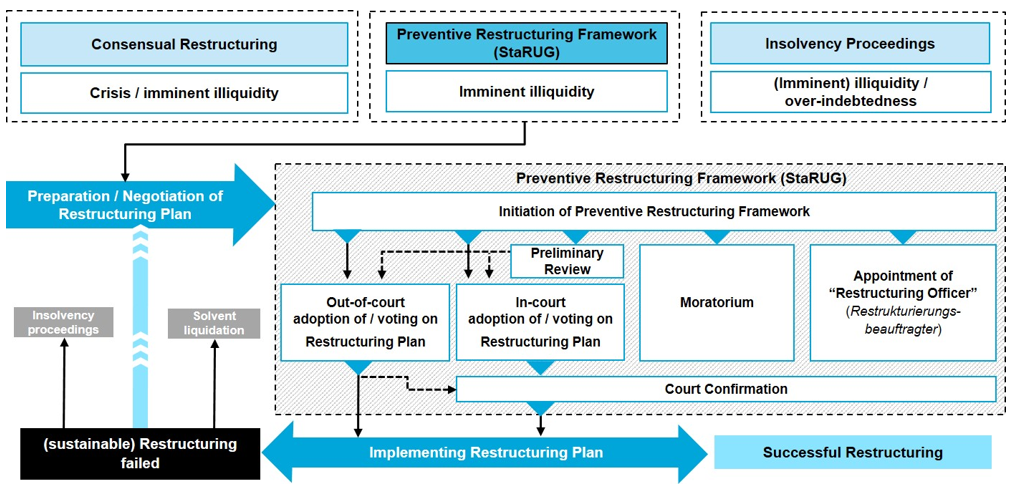
On 1 January 2021 the Corporate Stabilisation and Restructuring Act (StaRUG) has come into force and introduced the new ‘Preventive Restructuring Framework’ in Germany
6 min read
Prior to the introduction of the Preventive Restructuring Framework by the StaRUG out-of-court restructurings in Germany other than the restructuring of German law-governed bonds generally required unanimous approval by all affected creditors. Existing in-court procedures were only available in case of insolvency, and entailed substantial court involvement.
As a result of this gap, foreign proceedings, such as the English scheme of arrangement, have frequently been used by German companies in the context of pre-insolvency reorganizations in large cap situations. The new Preventive Restructuring Framework fills a gap in German restructuring law that exists between consensual pre-insolvency restructuring on the one hand and restructuring in the context of formal and comprehensive insolvency proceedings on the other. In particular, the new Preventive Restructuring Framework allows for an implementation of a restructuring plan by way of outvoting dissenting creditors and including the possibility of a cross-class cram-down.
Eligibility
In general, all debtors with a COMI in Germany except for Financial Institutions are eligible for the Preventive Restructuring Framework. The debtor must be imminently illiquid (drohend zahlungsunfähig) i.e. the debtor must more likely than not become unable to pay its debts within the next 24 months; further, the debtor must not (yet) be illiquid or over-indebted as in this case the directors of the debtor are under the strict duty to file for formal insolvency proceedings. (Overview see last page.)
Directors’ duties / Restructuring Officer
Upon initiation of the Preventive Restructuring Framework the (absolute) duty to file for insolvency upon occurrence of illiquidity or over-indebtedness is suspended; however, in such case directors have a strict duty to inform the Restructuring Court. Generally, the debtor's management remains in full control of the company and its business operations. However, in certain cases the Restructuring Court will appoint a so-called Restructuring Officer. Examples are where (i) the Restructuring Court orders a comprehensive set of stabilisation measures affecting substantially all creditors; or (ii) a cross-class cram-down is required. The Restructuring Officer will also be appointed upon request of the debtor or upon request of creditors making up 25% of the voting rights of their group if they commit to pay for the appointment. The Restructuring Officer supervises the restructuring and assesses the requirements. The Restructuring Officer reports to and is supervised by the Restructuring Court.
Moratorium
The debtor may apply for a moratorium on foreclosure and enforcement (also with regard to third-party security granted by the debtor’s affiliated companies). This application has to be filed with the Restructuring Court.
The Moratorium will initially be granted for a maximum period of three months. This period may be extended up to eight months, if the debtor has requested the judicial confirmation for a Restructuring Plan, approved by the creditors.
Restructuring Plan
The Restructuring Plan lies at the heart of the Preventive Restructuring Regime. The right to submit a plan lies exclusively with the debtor; however, affected creditors have the right to make proposals to amend the Restructuring Plan.
Permissible Modifications
The Restructuring Plan allows for modifications of liabilities and security rights granted by the debtor as well as in certain cases the underlying contractual relationships (gestaltbare Rechtsverhältnisse). Excluded are, inter alia, employee claims and certain tort claims. Further, an impairment of third-party security granted by the debtor’s affiliated companies can be agreed by the parties to the Restructuring Plan, but the secured creditors will need to be compensated for such an impairment. In addition, an infringement of shareholder rights, for example in the form of capital measures or the transfer of share or membership rights (including a pre-insolvency debt-for-equity swap) can be part of the Restructuring Plan.
Adoption of Restructuring Plan
The debtor can flexibly choose which (groups of) stakeholders to include in the Restructuring Plan. The choice must be reasonable and within each group, all creditors shall receive the same rights. To adopt the Restructuring Plan, a majority of 75% by value of claims within each group is required.
Further, the StaRUG provides for a cross-class cram-down mechanism: A dissenting class can be “crammed down”, if (i) the majority of classes vote in favour of the Restructuring Plan; (ii) members of the dissenting class can be expected to be in a position that is not worse than without the Restructuring Plan; and (iii) members of the dissenting class receive an adequate share in value created by the Restructuring Plan.
A class will be deemed to participate adequately in the value of the Restructuring Plan, if (i) no other creditor receives any value in excess of the amount of its claim; (ii) neither a subordinated creditor, the debtor nor the shareholders receives a value not fully compensated by a contribution into the debtor's assets (the so-called absolute priority rule); and (iii) no equal ranking creditor is better off than the creditors of the class concerned.
In certain cases the law provides for exceptions to the absolute priority rule, for example in situations where the debtor or shareholders retain an interest in the company’s assets, provided that their participation is necessary for the continuation of the company in order to achieve the added value of the Restructuring Plan, or the impairment of the rights of creditors is marginal, such as, for example, in case their rights are not impaired and the maturity dates of their claims are deferred by no more than 18 months.
Restructuring Court Involvement and confirmation
The debtor has the option to petition to the Restructuring Court to supervise the voting on the Restructuring Plan and to sanction the same following an adoption by the creditors.
In case of a Moratorium, the involvement of the Restructuring Court is mandatory.
Upon application, the Restructuring Court will opine on certain questions prior to the voting of the affected creditors on the Restructuring Plan, even where the Restructuring Court is not involved in the voting of the creditors.
A confirmation of the Restructuring Plan by the Restructuring Court can be requested and will be granted, if the formal requirements are met (in particular occurance and continuation of imminent illiquidity, adoption by the creditors, no violation of the rights of dissenting creditors or of the qualified absolute priority rule.
The confirmed Restructuring Plan has the effect of a final and binding court decision, allowing for direct enforcement. The Restructuring Officer may supervise the implementation of the Restructuring Plan.
Effects on lender liability and clawback
The StaRUG stipulates that the mere knowledge of an initiation of a Preventive Restructuring Regime does not suffice to imply lender liability or an intention to disadvantage other creditors. Thus, for certain clawback claims, there will no longer be grounds for the insolvency administrator in later, formal insolvency proceedings to challenge certain legal acts only because a Preventive Restructuring Framework had been initiated or because the debtor made use of the stabilization and restructuring measures of the Preventive Restructuring Framework.
Overview Procedure
White & Case means the international legal practice comprising White & Case LLP, a New York State registered limited liability partnership, White & Case LLP, a limited liability partnership incorporated under English law and all other affiliated partnerships, companies and entities.
This article is prepared for the general information of interested persons. It is not, and does not attempt to be, comprehensive in nature. Due to the general nature of its content, it should not be regarded as legal advice.
© 2021 White & Case LLP






